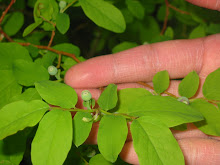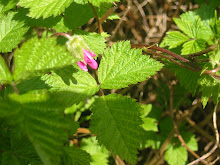12 000 years ago, ice covered the place we now call Vancouver, B.C. When the ice receded, 10 000 years ago, it left behind a scarred landscape. A small depression left by the ice became a lake surrounded by sedges and cattails. 5000 to 2000 years ago, the lake became a swamp. Dead plants from the swamp blocked the sources of fresh water and sediment. As the dead plants decayed, they used up available oxygen. 2000 years ago, conditions became perfect for a bog.
Low oxygen, low nutrients and acidic conditions are favoured by sphagnum moss, the keystone species of any bog. When sphagnum dies, it is called peat. Unlike most plant matter, which decays into humus, Peat decays very, very slowly, helping the top layer of living sphagnum grow by conducting water (osmosis). New sphagnum grows right on top of the dead sphagnum. So a bog is like a many layered cake, taking thousands of years to "bake". Peat decays so slowly that digging through Camosun bog is a bit like digging through time. Each metre below the surface represents about 400 years. Occasionally human bodies are found in bogs, exquisitely preserved by the acidic peat. We have never found bodies in Camosun bog, but other interesting artifacts have turned up, including a hockey puck from the 1940s when the local boys used to play hockey on Devil's Hole.
The slow rate of decay in a bog means that it is an excellent carbon sink, a vital ally in our fight against global warming. Bogs convert carbon dioxide to peat and the preserved peat do not release their carbon until they slowly decay over thousands of years. Burns bog is often called the "Lungs of the Lower Mainland".
Camosun bog, xʷməm̓qʷe:m is the traditional territory of the Musqueam people. There is evidence of their use of the bog region for the past 4000 years. According to their oral history of the region, their activity here dates back 9000 years. Camosun bog has been a source of story, tradition and medicine for the Musqueam.
It was the development of a city that nearly destroyed the bog. Drains installed in 1929 reduced the water levels, destroying the Sphagnum moss. The resulting influx of nutrients caused the native bog plants to be outcompeted by invasive ones. And a Hemlock forest grew where a stable bog existed for over 2000 years. The hemlock trees, rooted in peat, behave like a forest planted in a waterbed. Trees easily fell over in a windstorm. You can jump in the forest and watch the ground move in waves.
In 1972, construction fill was dumped onto the bog site, further exacerbating a bad situation. The bog was nearly gone. In 1992, a group of concerned neighbours and researchers formed the Camosun Bog Restoration Group (the "Crazy Boggers"). This group explored ways to revive the bog before it was completely wiped out. After some experimentation, the group chose to remove the top 15 - 20 cm of nutrient rich soil and actively plant sphagnum moss. Bog species such as bog laurel, labrador tea and lodgepole pine were also replanted. Some species returned on its own: sundew, arctic starflower, and cloudberry came back in patches.
Hermansen and Wynn analyze the meaning of bog restoration in their urban geography paper "Reflections on the Nature of an Urban Bog". Garth Thompson writes eloquently of the healing nature of restoration work. Every week, the CBRG maintains the bog through Saturday work parties. Anyone is welcome to join. You can read more about the history of Camosun bog and its restoration here.
Subscribe to:
Comments (Atom)













